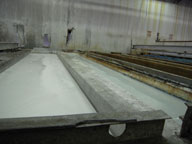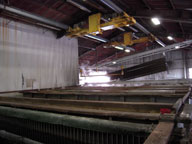Anodizing
Custom Craftsmanship
And Elegant Design
Architects and designers specify Wilson Partitions anodized aluminum for its strength, durability, beauty, finish, and superior quality. End-users find that our anodized interior aluminum products fit well into their lifestyle.
Behind the lustrous finishes that anodized aluminum provides is the story of a scientific process that produces a thin, durable film that can withstand nature’s toughest conditions. This is because anodizing is a natural oxidation process sped up by science and technology to create a finish that is non-staining, non-absorbing, non-reacting, and non-corroding – all requirements of long-lasting architectural finishes and products.
The steps involved in anodizing require excellent know-how and knowledgeable staff trained in environmental stewardship, chemical processes, and health and safety standards. The task of undertaking an in-house anodizing line is monumental but well worth the control and flexibility that in-house anodizing provides for our customers. Wilson Partitions is able to deliver timely anodized aluminum inspected numerous times by our trained staff for quality control assurances. Thus, we are able to provide a warranty service that is backed by our quality-driven standards-versus that of an outside anodizing company.
Finishes
Wilson Partitions’ in-house anodizing and painting services offer you maximum flexibility for your project.
Downloads:
Wilson Partitions’ Anodizing Process
Steps 1 & 2: Cleaning
Aluminum extrusions are first cleaned in soap and a hot water tank in order to get rid of contaminants including dirt and light oils.
Extrusions are then rinsed in order to remove all byproducts of the previous stage.
Step 3: Etching
This process places aluminum extrusions into a caustic bath designed to get rid of light scratches and develop a smooth, matte finish.
Step 4: Deoxidizing and Desmutting
Aluminum extrusions are rinsed a number of times and then placed into an acidic rinse in order to remove residue that may be left over from the previous caustic bath. After another rinsing, extrusions are now ready for anodizing.
Step 5: Anodizing Aluminum
Aluminum extrusions are placed in a sulfuric acid anodizing tank. Anodizing leaves behind a hard, porous layer of aluminum and oxygen that is resistant against scratches and wear from the natural environment. Below is a picture of the basic structure of anodized aluminum.
Once coating is built to the required thickness, extrusions are sealed if the color desired is clear. Otherwise, extrusions are placed in the tin coloring tank.
Step 6: Electrolytic Coloring or “Two Step”
The pores created in the anodizing tank allows color to be deposited into it. Wilson Partitions deposits tin into the aluminum extrusions. The amount of tin that is deposited into the pores determine the resulting color. Light Champagne only requires 18 seconds while black ano takes about 12 minutes.
Step 7: Sealing the Anodic Coatings
Extrusions are then placed in the seal tank. This closes the pore structures so that colors remain permanent. It also makes the aluminum non-reactive, non-absorbing, and non-corroding. Extrusions are then rinsed in a hot bath in order to speed up the drying process.
Contact Us
West Coast
2301 E. Vernon Ave.
Vernon, CA 90058
Phone: 866.443.7258
Fax: 323.908.5451
Central
7601 Ambassador Row, Suite 102
Dallas, TX 75247
Phone: 214.295.2165
Fax: 214.496.0156
7505 Bluff Point Drive, Suite 100
Houston, TX 77086
Phone: 713.405.3353
East Coast
110 Viaduct Road
Stamford, CT 06907
Phone: 203.316.8033
Fax: 203.316.0019





